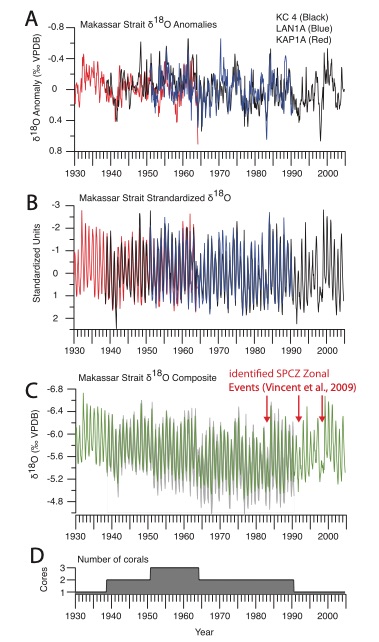Abstract: Seasonal surface freshening of the Makassar Strait, the main conduit of the Indonesian Throughflow (ITF), is a key factor controlling the ITF. Here we present a 262-year reconstruction of seasonal sea-surface-salinity (SSS) variability from 1742-2004 C.E. using coral δ18O records from the central Makassar Strait. Our record reveals persistent seasonal freshening and also years with significant truncations of seasonal freshening that correlate exactly with South Pacific Convergence Zone (SPCZ) zonal events >4,000 km to the east. During these events, the SPCZ dramatically rotates ~15° north to near the equator and stronger westward flowing South Pacific boundary currents force higher salinity water through the Makassar Strait in February-May halting the normal seasonal freshening in the strait. By these teleconnections, our Makassar coral δ18O series provides the first record of the recurrence interval of these zonal SPCZ events and demonstrates that they have occurred on a semi-regular basis since the mid-1700s.
Podcast about paper:
http://climateandlife.columbia.edu/2017/02/09/indonesian-corals-shed-light-on-climate-system/
SPCZ normal orientation in January 2006 and zonal orientation in February 1998 and January 2016
Figure 1: Sea surface salinity (SSS) data for the western tropical Pacific and Indonesia from the SODA SSS data base (Carton and Giese, 2008) for: (A) March 1982, (B) March 1983, (C) March 1991, (D) May 1992, (E) March 1997, and (F) March 1998. The right hand column of 3 panels for March 1983, May 1992 and March 1998 are when the South Pacific Convergence Zone (SPCZ) was determined from GPCP Global precipitation climatology project (Adler et al., 2003) data to be in a “zonal” orientation (Vincent et al., 2009). White box in the Makassar Strait indicates our study sites. The increase in SSS along the equator during the SPCZ zonal events (right column) coincides with increases in the South Equatorial Current (SEC), the New Guinea Coastal Current (NGCC) and New Guinea Coastal Under Current (NGCUC) and the truncation of seasonal freshening in the Makassar Strait (also see Figures S2-S5).
Figure 2: (A) Location of study sites at Kapoposang and Langkai in the Makassar Strait in relation to bathymetry and general flow vectors for the Indonesian Throughflow (ITF). (B) Vertical salinity profiles in the upper 500m of salinity (from climatology) for the different seasons (Conkright et al., 1998). (C) SODA SSS (blue) and IGOSS SST (black) data from grid box containing Kapoposang at study site in the Makassar Strait. (D) Kapoposang coral core KC4 oxygen isotope (black) and pseudo-coral forward model results using SST and SSS to estimate coral oxygen isotope (green). Red arrows indicate the years of previously identified zonal SPCZ events.
Figure 3: Coral oxygen isotope results of cores KC4, KAP1A and LAN1A from the central Makassar Strait for the period 1930-2004. (A) Coral oxygen isotope anomalies with the average seasonal cycle removed, (B) Standardized coral oxygen isotope to adjust for oxygen isotope offsets between cores (mean removed and per standard deviation), (C) Composite average coral oxygen isotope from the 3 cores and (D) number of cores used in the composite for different time periods. Prior to 1938 with only core KAP1A extending back to 1742.
Figure 4: (A) Makassar Strait composite coral δ18O series with seasonal δ18O minima (fresh season) highlighted in blue. (B) Makassar Strait coral δ18O fresh season minima isolated from a 3 year band-pass filtered and centered composite coral δ18O series where all variability with periods greater than 36 months had been removed (C) Makassar Strait coral δ18O peak seasonal fresh season (February-March) differences from average fresh season δ18O using the 36 month filtered data. The top 10 and top 20 anomalously high δ18O (higher salinity) fresh seasons were then determined by ranking the results. We interpret the top ~20 truncated freshening events in the Makassar Strait as times when the SPCZ was in a more zonal orientation during February-May of that year (see text).






